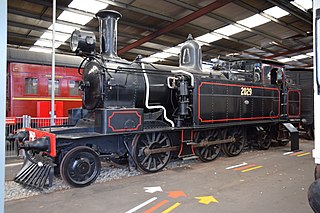Coombing Park is a farming property situated in western New South Wales just off the Mid-Western Highway about 5 km west of Carcoar, 260 km west of Sydney and 54 km south-west of Bathurst. The property is of considerable note because of its relationship with convicts, bushrangers and the Cobb & Co coaching company. The property was offered as an estate to its owner Thomas Icely by the early New South Wales Government in 1826. It was one of the first estates created on the western side of the Blue Mountains that border the area of Sydney.
Lysaght was founded in 1880 by John Lysaght as a subsidiary to the company John Lysaght and Co. The company pioneered modern steel coating technologies (galvanization). Its coated steel building products were sold under the 'ORB' brand and contributed to Australian architectural style.
The Main Western Railway is a major railway in New South Wales, Australia. It runs through the Blue Mountains, Central West, North West Slopes and the Far West regions. It is 825 kilometres (513 mi) with 484 kilometres (301 mi) operational & 341 kilometres (212 mi) under construction & repairs.
The New South Wales 85 class were a class of 10 electric locomotives built by Comeng, Granville between May 1979 and July 1980 for the Public Transport Commission.
Tallawang is an historical locality north of Gulgong in central western New South Wales, Australia. The place name is derived from an aboriginal word for "apple gum".
Spring Hill is a small village 13 km south-east of Orange, Australia. Its buildings date back to the 1870s and a Heritage Trail has been established for tourists. At the 2016 census, Spring Hill had a population of 502 people.

The New South Wales Z20 class was a class of 2-6-4T steam locomotives operated by the New South Wales Government Railways of Australia.

Albert is a town in the Central West region of New South Wales, Australia. The town is in the Lachlan Shire local government area, 481 kilometres (299 mi) west north west of the state capital, Sydney. At the 2016 census, Albert had a population of 81, though Albert once had a population of 900.

Leadville is a town in New South Wales, Australia. The town is located in the Warrumbungle Shire local government area, 376 kilometres (234 mi) north west of the state capital, Sydney. At the 2016 census, Leadville and the surrounding area had a population of 169.

William Sandford was an English-Australian ironmaster, who is widely regarded as the father of the modern iron and steel industry in Australia.

Port Kembla is a man-made cargo port or artificial harbour, with an outer harbour protected by breakwaters and an inner harbour constructed by dredging, located in the Illawarra region of New South Wales, Australia.

NSW Wallaby was a steam locomotive seeing service in New South Wales.
The D1 class were a class of diesel locomotives built by Commonwealth Engineering, Granville with English Electric traction equipment for Australian Iron & Steel's, Port Kembla steelworks in 1950-1951.

Jerrawa is a locality in the Upper Lachlan Shire, New South Wales, Australia. It lies on the north side of the Hume Highway about 30 km to the east of Yass and was served by Jerrawa railway station on the Main Southern line between Sydney and Melbourne between 1876 and 1975. At the 2016 census, it had a population of 73.
Cadia is a locality in the Cabonne Council of New South Wales, Australia. It was formerly a private township established c. 1860s by the Cadiangullong Consolidated Copper company. It is now part of the Cadia-Ridgeway Mine lease, operated by Newcrest. It had a population of zero as of the 2016 census.

The Lithgow Blast Furnace is a heritage-listed former blast furnace and now park and visitor attraction at Inch Street, Lithgow, City of Lithgow, New South Wales, Australia. It was built from 1906 to 1907 by William Sandford Limited. It is also known as Eskbank Ironworks Blast Furnace site; Industrial Archaeological Site. The property is owned by Lithgow City Council. It was added to the New South Wales State Heritage Register on 2 April 1999.

The Chalybeate Spring at Mittagong, New South Wales was a perennial, carbonated, chalybeate (iron-rich) mineral spring

Charles Henry Hoskins (1851-1926) was an Australian industrialist, who was significant in the development of the iron and steel industry in Australia.
Australian Iron & Steel was an Australian iron and steel manufacturer.

Sir Cecil Harold Hoskins (1889–1971) was an Australian industrialist associated with the iron and steel industry. He is notable mainly for the establishment of the steel industry at Port Kembla, the company Australian Iron & Steel, and its subsequent merger with BHP in 1935. He was also on the board of the Australian Mutual Provident Society for many years and was its chairman from 1947 to 1962. He is less well known for his involvement in centre-right political organisations and the scouting movement, and his interest in landscape gardens.











